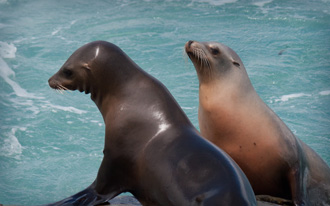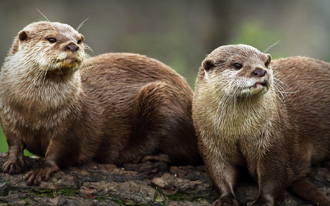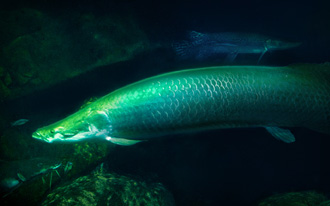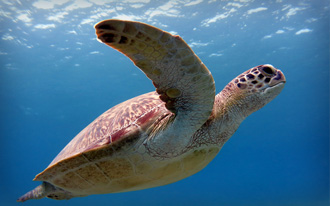We Introduce 10 STAR Species In The Aquarium
Introduction Of Star Species Of The Aquarium

Cownose ray
Cownose ray measures approximately 28~46cm and grows fast.
In general, a grown cownose has a white or light yellow belly.
To protect itself from danger, it uses the barb of its tail.

Humboldt penguin
This penguin catches fish while living on a small island of the coast where
the Peru current flows. It makes a simple nest among rocks or in caves and
lays 2 eggs. There is a thick black band on the upper side of its chest.
Young penguins have a dark color overall and they have no band on the chest.

Asian small-clawed otter
As the smallest breed of otters, it weighs 1~5.4kg and is 70~100cm long
with the tail approximately 30cm.
Otters hunt preys in water and its physical characteristics are suited for hunting.
The valves inside the small, round ears and nostrils are automatically closed
when otters dive. They can detect fish in the water using their sensitive whiskers.

Pirarucu
The world’s largest body color pattern turns red starting from the tail.
Pirarucu climbs to the surface of the water to inhale the oxygen in the air
and breathes the oxygen gathered in its air bladder.
Since the local natives started to use pirarucu for food and daily necessities,
it has become endangered due to the indiscrete hunting and pollution of its
habitat.

Piranha
This is a carnivorous fish which name means “toothed fish” in the local language.
Piranha has an extremely powerful lower jaw as well as sharp triangular teeth.
In the wild, it eats a variety of species such as fish, reptiles or mammals.
They also prey upon the same species - any sick or weak piranha among a colony
is instinctively eaten.

Electric eel
Electric eels inhabit the muddy place of the Amazon River.
To supplement its poor eyesight, it produces electricity through
power-generating apparatuses located on both sides of its body.
They detect organisms in the water, send signals to other species and stun preys
in the vicinity using generated electricity. Their electricity is 650~850V,
the highest level among fish.

Sardines
Sardines live in the coastal areas of Korea, China and Japan,
and have a blue back and a silver-colored belly. Sardines measure 12~20cm long.
To avoid being eaten by carnivorous species, they live in groups by forming
fishballs.

Anemone fish
Anemone fish have 3 white stripes that cross its light orange body.
It lives among coastal reefs and establishes mutual relationship with sea
anemone where it lures prey for the sea anemone using its conspicuous color
and lives on the food left by the sea anemone. Anemone fish is capable
of changing sex which although born male, it changes its sex
when the breeding female dies.

Sea horse
Sea horse is the fish with a unique appearance which resembles a horse.
The length a sea horse can protect its body is approximately 6~10cm.
Sea horse lives its entire life under the monogamy system and breeds
in a unique method where males incubate eggs. It sucks water using its thin
and long mouth and preys upon the animal plankton or small prawns contained
in the water.

Sea turtle
Sea turtles inhabit the tropical and subtropical sea of the entire world except
the Arctic Sea. The spawning ground is not protected, and this turtle is
an endangered species due to reckless hunting. Its beak is similar to that of
a parrot. The sea turtle eats marine algae or fish or jellyfish at times.
Since the back skin is solid, it can protect itself from carnivorous species such as
shark. Using the flipper, the turtle can swim for a long distance at a speed of
1.5~2.3km/hour.